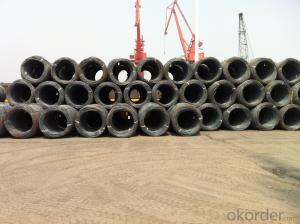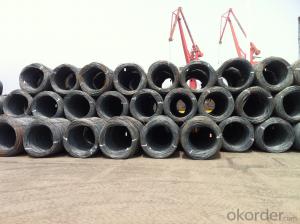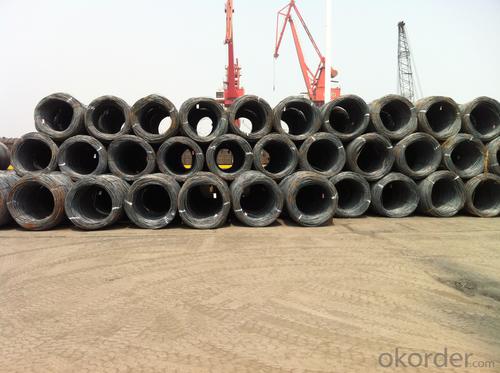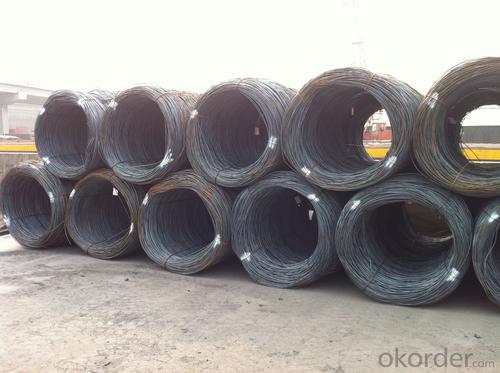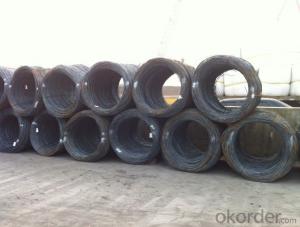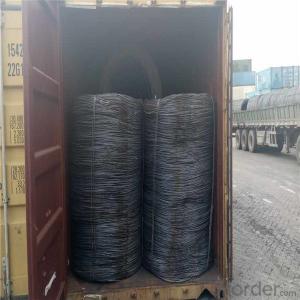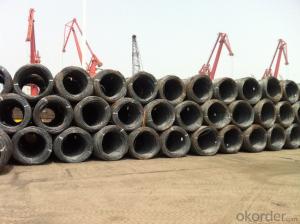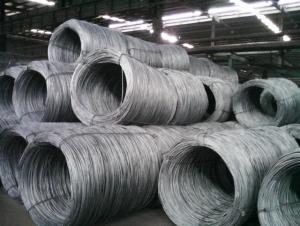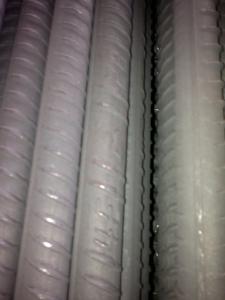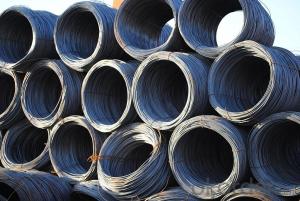Wire rod SAE 1006-1018 with Best Quality and Lowest Price
- Loading Port:
- Tianjin
- Payment Terms:
- TT OR LC
- Min Order Qty:
- 25 m.t
- Supply Capability:
- 20000 m.t/month
OKorder Service Pledge
OKorder Financial Service
You Might Also Like
Specification
OKorder is offering Hot Rolled Carbon Steel Wire Rod 5.5mm with High Quality at great prices with worldwide shipping. Our supplier is a world-class manufacturer of steel, with our products utilized the world over. OKorder annually supplies products to European, North American and Asian markets. We provide quotations within 24 hours of receiving an inquiry and guarantee competitive prices.
Product Applications:
Hot Rolled Carbon Steel Wire Rod 5.5mm with High Quality is widely used in construction and manufacturing. Carbon steel wire rod is mainly used for reinforcement of reinforced concrete and welded structure or reprocessed (roberts , nail, etc.) materials, especially used to produce wire drawing, welding electrode, nails, spring, electronic, precise machinery parts and so on.
Product Advantages:
OKorder's Hot Rolled Carbon Steel Wire Rod are durable, strong.packed and suitable for wire mesh,nail manufacture and construction
Main Product Features:
· Premium quality
· Prompt delivery & seaworthy packing (30 days after receiving deposit)
· Can be recycled and reused
· Mill test certification
· Professional Service
· Competitive pricing
Product Specifications:
Manufacture: Hot rolled
Grade: SAE1006 SAE1008 SAE1010 SAE1012 SAE1016 SAE1018
Certificates: ISO, SGS, BV, CIQ
Weight per Coil:2-2.05tons
Packaging: Export packing, packed by coil
Grade | Chemical Composition (%) | |||||
C | Mn | S | P | Si | B | |
SAE1006B | 0.03~O.07 | 0.32max | 0.045max | 0.040max | 0.30max | 0.0008min |
Mechanical properties | ||||||
Yield strength(N/mm2) | Tensile strength(N/mm2) | Elongation (%) | ||||
250-280 | 350-380 | ≥32 | ||||
Grade | Chemical Composition (%) | |||||
C | Mn | S | P | Si | B | |
SAE1008B | 0.10max | 0.3~0.50 | 0.050max | 0.040 max | 0.15max | 0.0008 min |
Mechanical properties | ||||||
Yield strength(N/mm2) | Tensile strength(N/mm2) | Elongation (%) | ||||
≥195 | 315-430 | ≥30 | ||||
FAQ:
Q1: Why buy Materials & Equipment from OKorder.com?
A1: All products offered byOKorder.com are carefully selected from China's most reliable manufacturing enterprises. Through its ISO certifications, OKorder.com adheres to the highest standards and a commitment to supply chain safety and customer satisfaction.
Q2: How do we guarantee the quality of our products?
A2: We have established an advanced quality management system which conducts strict quality tests at every step, from raw materials to the final product. At the same time, we provide extensive follow-up service assurances as required.
Q3: How soon we can delivery the goods ?
A3: We have a mill with 20000mts of capacity per month. We can delivery the goods within in one month ,as long as your order quantity less than 20000mts
Q4:What's your payment terms ?
A4:Mostly,we collect the money by T/T and LC at sight . We also accept time LC at 90/120 days sight.
Image:
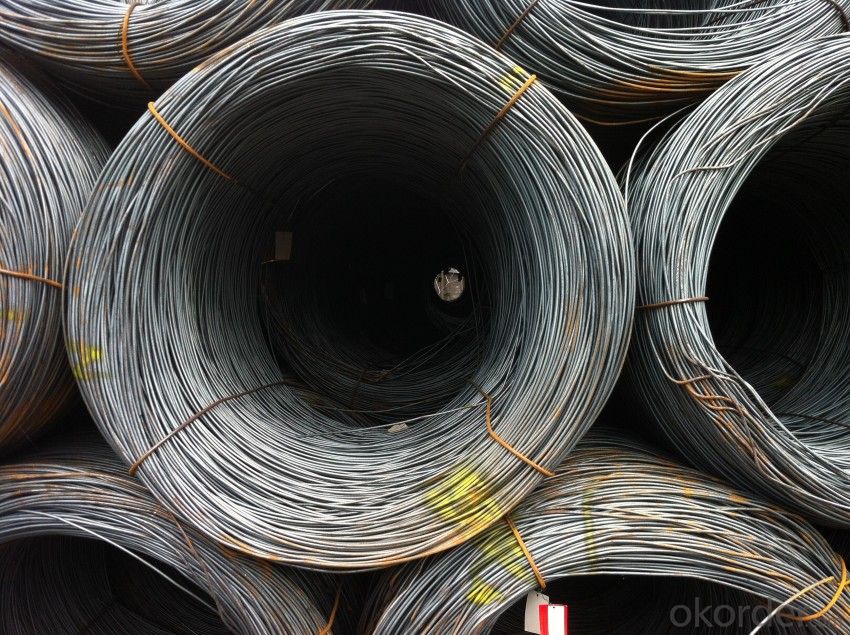
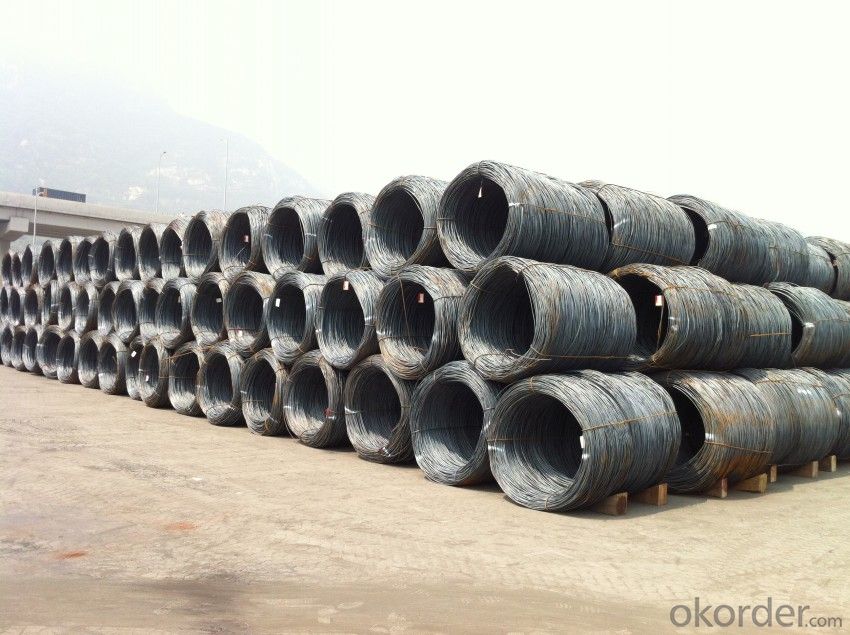
- Q: What are the common applications of stainless steel wire rod?
- Due to their exceptional properties and versatility, stainless steel wire rods are extensively utilized in various industries. These wire rods have numerous applications in different sectors: 1. In the manufacturing industry, stainless steel wire rods are widely employed for producing a variety of products. They are commonly utilized in the manufacturing of small components like springs, fasteners, screws, bolts, and more. The outstanding tensile strength and corrosion resistance of stainless steel make it an ideal material for such purposes. 2. The construction industry heavily relies on stainless steel wire rods for structural applications. These rods are used to reinforce concrete structures such as bridges, buildings, and tunnels, enhancing their strength and durability. The corrosion resistance of stainless steel makes it suitable for outdoor applications where exposure to moisture and harsh weather conditions is prevalent. 3. The automotive industry extensively utilizes stainless steel wire rods. They are employed in the production of various components including exhaust systems, suspension springs, and engine parts. The high strength and heat resistance of stainless steel make it well-suited for such applications, ensuring longevity and performance even under demanding conditions. 4. In the aerospace industry, stainless steel wire rods are widely employed. They are utilized for manufacturing aircraft components such as cables, fasteners, and landing gear parts. The exceptional strength-to-weight ratio of stainless steel makes it an ideal material for aerospace applications where lightweight and high-performance materials are crucial. 5. The medical industry also benefits from the applications of stainless steel wire rods. These rods are used for manufacturing surgical instruments, orthopedic implants, and medical devices. The biocompatibility and corrosion resistance of stainless steel are crucial properties for such applications, ensuring the safety and durability of medical equipment. 6. The food processing industry extensively utilizes stainless steel wire rods. They are employed in the production of equipment like conveyor belts, sieves, and filters that come into contact with food products. The high corrosion resistance and hygiene properties of stainless steel make it an ideal material for food processing applications, ensuring product safety and compliance with food regulations. In conclusion, the exceptional properties of stainless steel wire rods make them highly versatile and applicable across various industries. Their high strength, corrosion resistance, heat resistance, and biocompatibility enable the manufacturing of a wide range of products, from small components to large-scale structures.
- Q: What are the different types of steel wire rod surface defect monitoring systems?
- There are several types of steel wire rod surface defect monitoring systems available, including visual inspection systems, automated optical inspection systems, electromagnetic inspection systems, and ultrasonic inspection systems.
- Q: What are the common industry qualifications for steel wire rod suppliers?
- The common industry qualifications for steel wire rod suppliers typically include certifications such as ISO 9001:2015 for quality management systems, ISO 14001:2015 for environmental management systems, and OHSAS 18001:2007 for occupational health and safety management systems. Additionally, suppliers may be required to adhere to industry-specific standards such as ASTM A510, ASTM A370, and ASTM A510M. It is also important for suppliers to have a strong track record of delivering consistent quality products, meeting customer specifications, and maintaining reliable production and delivery capabilities.
- Q: How are steel wire rods used in the production of tire cords?
- Steel wire rods are used in the production of tire cords by being transformed into a high tensile strength wire that is then twisted and coated with rubber. These cords are embedded within the tire structure, providing reinforcement and improving its durability, stability, and resistance to punctures and impacts.
- Q: How is steel wire rod used in the production of fasteners?
- Steel wire rod is used in the production of fasteners as it serves as the primary material for manufacturing various types of fasteners such as screws, bolts, and nails. The wire rod undergoes a series of processes including drawing, forming, and cutting to transform it into the desired shape and size of the fastener. The high strength and durability of steel make it an ideal choice for fasteners, ensuring that they can withstand the required tension and load-bearing capacities.
- Q: How is steel wire rod used in the manufacturing of wire baskets for industrial applications?
- Steel wire rod is a primary material used in the manufacturing of wire baskets for industrial applications. It serves as the base material that is shaped, bent, and welded to create the framework of the basket. The high tensile strength and durability of steel wire rod make it ideal for withstanding heavy loads and rough handling in industrial environments. Additionally, the steel wire rod can be coated or galvanized to enhance corrosion resistance, ensuring longevity and reliable performance of the wire baskets.
- Q: How is steel wire rod used in the production of suspension springs for marine vessels?
- Steel wire rod is commonly used in the production of suspension springs for marine vessels due to its high strength and durability. It is typically formed into coils or helical shapes to create the springs, which provide support and absorb shocks and vibrations on the vessel. The steel wire rod's superior tensile strength allows the suspension springs to withstand heavy loads and harsh marine environments, ensuring the stability and safety of the vessel.
- Q: How does the ductility of steel wire rod vary with different heat treatment processes?
- Different heat treatment processes can have a significant impact on the ductility of steel wire rod. Processes such as annealing, quenching, and tempering can alter the microstructure and mechanical properties of the steel wire rod. Annealing involves heating the steel wire rod to a specific temperature and then slowly cooling it down. This process relieves internal stresses and refines the grain structure of the steel, resulting in increased ductility. The reduction in dislocations and the formation of a finer grain structure allow for greater plastic deformation before fracture. Quenching, on the other hand, rapidly cools the steel wire rod from a high temperature to room temperature or below. This sudden transformation of the microstructure makes the material harder and more brittle, causing a significant decrease in ductility. The formation of martensite, a hard and brittle phase, restricts the material's ability to undergo plastic deformation. Tempering, which follows quenching, involves reheating the steel wire rod to a lower temperature and then cooling it at a controlled rate. This process relieves some of the internal stresses induced by quenching and transforms some of the brittle martensite into a more ductile phase called tempered martensite. As a result, the ductility of the steel wire rod can be partially restored. The tempered martensite has reduced hardness but retains some of the strength and hardness obtained during quenching. In conclusion, the ductility of steel wire rod can vary significantly with different heat treatment processes. Annealing increases ductility by promoting a finer grain structure and reducing internal stresses. Quenching decreases ductility due to the formation of a hard and brittle martensitic structure. Tempering can partially restore ductility by transforming some of the martensite into a more ductile phase. The specific heat treatment process, including temperature, cooling rates, and duration, determines the extent of the changes in ductility for steel wire rod.
- Q: How is the steel wire rod industry regulated?
- The steel wire rod industry is regulated through a combination of government regulations and industry standards. Governments typically set regulations on areas such as product quality, safety standards, environmental impact, and labor practices. These regulations ensure that the industry operates within certain parameters to protect the interests of consumers, workers, and the environment. Additionally, industry standards and certifications are often established by professional associations or organizations to further regulate and ensure the quality and safety of steel wire rod products.
- Q: How is steel wire rod tested for hardness?
- Steel wire rod is typically tested for hardness using a method called the Rockwell hardness test. In this test, a small indenter is pressed into the surface of the wire rod under a specified load. The depth of penetration is measured, and a hardness value is determined based on the depth of indentation. This test helps assess the wire rod's ability to resist deformation and indicates its suitability for various applications.
Send your message to us
Wire rod SAE 1006-1018 with Best Quality and Lowest Price
- Loading Port:
- Tianjin
- Payment Terms:
- TT OR LC
- Min Order Qty:
- 25 m.t
- Supply Capability:
- 20000 m.t/month
OKorder Service Pledge
OKorder Financial Service
Similar products
Hot products
Hot Searches
Related keywords
